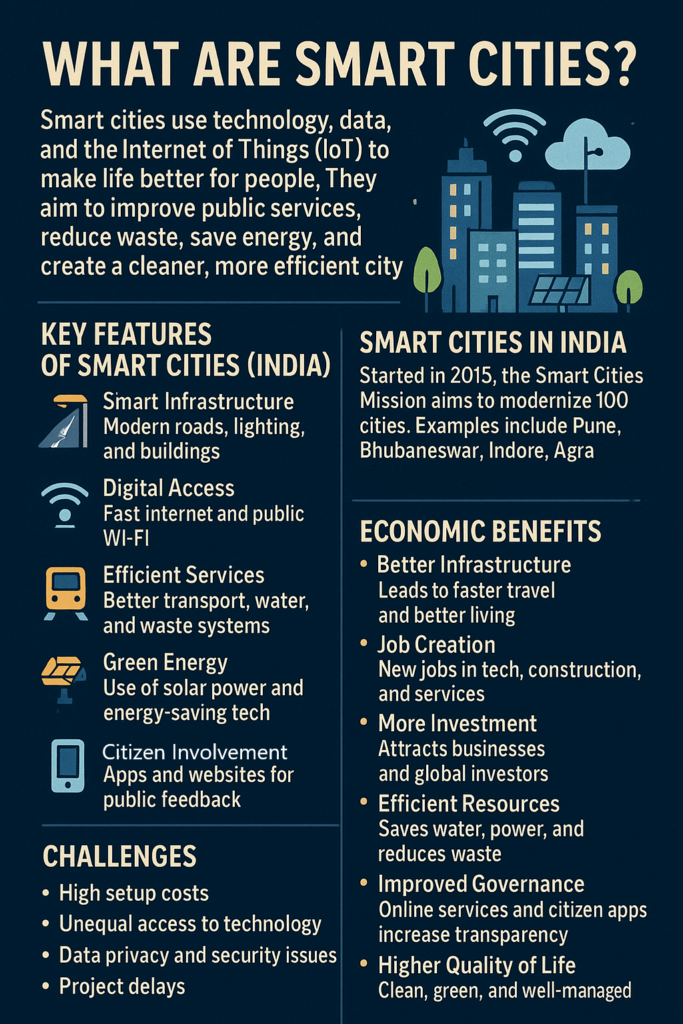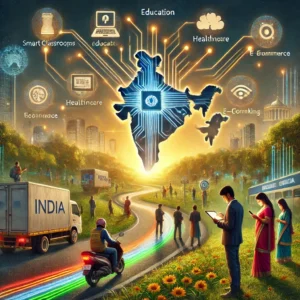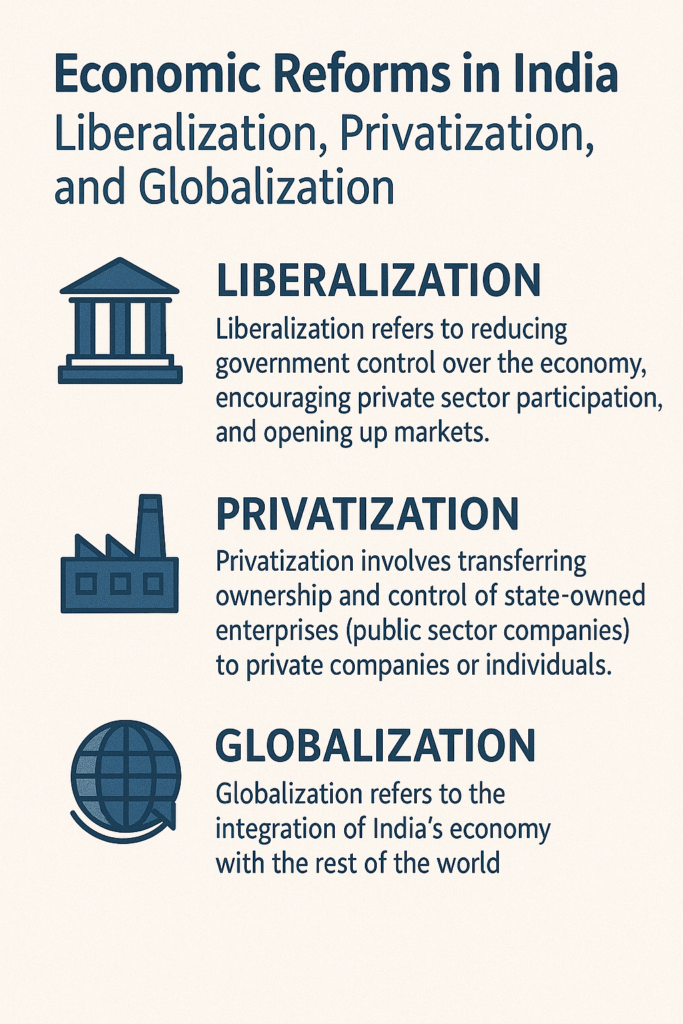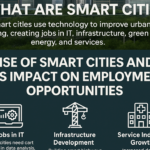What are Smart Cities?
A smart city is a city that uses technology and digital solutions to improve the quality of life for its residents, make services more efficient, and make the city more sustainable. In a smart city, data, IoT (Internet of Things), and technology are used to manage and optimize various aspects of the city, such as transportation, energy, healthcare, and waste management.

Key Features of Smart Cities in India
- Smart Infrastructure: Cities have advanced infrastructure like smart roads, buildings, and lighting systems.
- Digital Connectivity: High-speed internet and Wi-Fi services are available to residents.
- Efficient Public Services: Smart cities use technology to improve services like waste management, water supply, and public transportation.
- Sustainable Energy: Solar power, energy-efficient buildings, and smart grids are used to reduce energy consumption and environmental impact.
- Citizen Engagement: Residents can access services, report issues, and provide feedback through mobile apps and websites.
The Rise of Smart Cities in India
India’s government has been working on the development of Smart Cities under the Smart Cities Mission, which was launched in 2015. The goal is to transform 100 cities across India into smart cities with advanced infrastructure and better living standards.
Some of the cities already becoming smarter include:
- Pune
- Bhubaneswar
- Indore
- Agra
- Chandrapur
Economic Impact of Smart Cities in India
The rise of smart cities in India has a big impact on the economy in several ways. Let’s look at the key areas where smart cities are having a positive effect:
1. Improved Infrastructure and Urban Development
Smart cities focus on better infrastructure, including modern roads, bridges, efficient water supply, and sewage systems. This leads to:
- Faster and Safer Travel: With better transportation systems, people can travel more efficiently, reducing time spent in traffic. This saves both time and money.
- Better Living Conditions: Smart infrastructure leads to cleaner, greener, and more organized urban spaces, improving the quality of life for residents.
- Attracting Investments: High-quality infrastructure makes cities more attractive to businesses, leading to economic development and more job opportunities.
2. Job Creation and Employment Opportunities
As smart cities are developed, they require a lot of work in various sectors:
- Construction and Development: Building smart infrastructure creates jobs in construction, design, and engineering.
- Tech and IT Jobs: Since smart cities rely on technology, there’s a demand for IT professionals, data analysts, and software developers to design and maintain the digital systems.
- Service Sector Jobs: New businesses, hotels, and services open in these smart cities, leading to the creation of service sector jobs like customer service, retail, and healthcare.
In the long term, the rise of smart cities will continue to create millions of jobs across different sectors.
3. Boosting Economic Growth and Investment
Smart cities can attract both domestic and international investments due to their efficient, modern, and tech-driven environment. Investors are more likely to invest in cities that offer:
- Advanced Infrastructure: Efficient transport systems, energy solutions, and better public services reduce operational costs for businesses.
- Business Opportunities: The rise of smart cities creates opportunities for businesses in sectors like real estate, technology, renewable energy, and e-commerce.
- Public-Private Partnerships (PPP): Many smart city projects involve collaboration between the government and private companies, which helps accelerate development and brings in additional funds.
This investment not only strengthens the local economy but also contributes to national growth.
4. Efficient Use of Resources
One of the major advantages of smart cities is the efficient use of resources, such as water, electricity, and waste. Here’s how:
- Energy Efficiency: Smart cities use technologies like smart grids to reduce energy consumption. This helps lower electricity costs and makes energy usage more sustainable.
- Water Management: Smart water systems help monitor and reduce water wastage, which is critical in areas facing water shortages.
- Waste Management: Technology helps in collecting and recycling waste more efficiently, making the city cleaner and more sustainable.
This efficient use of resources leads to cost savings for both the government and residents, freeing up funds for other economic development projects.
5. Better Governance and Transparency
Smart cities use technology for better governance. This helps improve transparency and accountability in government services. Here’s how it works:
- Online Services: Citizens can access government services like paying taxes, applying for permits, and getting documents through online portals. This reduces corruption and delays.
- Smart Monitoring: Smart cities use data analytics to track and monitor services, which allows governments to identify and fix issues quickly.
- Citizen Engagement: Mobile apps and platforms allow residents to report problems (like broken streetlights or traffic issues) directly to authorities. This encourages more active participation in civic matters.
This leads to more effective governance and makes the city more attractive to investors, as they see that it’s well-managed and transparent.
6. Enhancing Sustainability and Quality of Life
Smart cities are designed with sustainability in mind. They use technology to promote environmental conservation and improve the quality of life for residents:
- Green Spaces: Smart cities are built with parks, recreational areas, and open spaces, improving the overall well-being of residents.
- Public Transport: Efficient, eco-friendly public transport systems reduce traffic congestion, pollution, and the city’s carbon footprint.
- Waste-to-Energy: Some smart cities have systems to convert waste into energy, reducing environmental impact and creating a renewable energy source.
A cleaner, greener city leads to a better quality of life, which attracts more people and businesses to move to these areas.
Challenges in Developing Smart Cities
While smart cities offer huge potential, there are some challenges:
- High Costs: Building smart cities requires a large investment in infrastructure, technology, and services.
- Digital Divide: Not everyone has equal access to the technology or skills needed to fully benefit from a smart city. Efforts must be made to bridge the gap.
- Security Concerns: With the increase in digital services, smart cities must ensure strong cybersecurity to protect citizens’ data and privacy.
- Implementation Delays: Many smart city projects face delays in execution, which can slow down the intended economic benefits.
Conclusion
The rise of smart cities in India is a game-changer for the economy. By improving infrastructure, creating jobs, attracting investments, and using resources efficiently, smart cities are playing a crucial role in India’s economic development. As more cities adopt smart technologies, the overall economy will become more sustainable, connected, and innovative.











